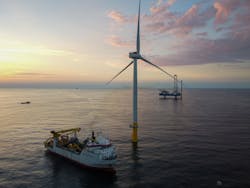First turbines installed in federal waters
Jessica Stump * Assistant Editor
In September, the first offshore wind farm in US federal waters delivered first power to the grid. The Coastal Virginia Offshore Wind (CVOW) pilot project is the first approved by the Bureau of Ocean Energy Management (BOEM) and the second offshore wind farm constructed in the US. It is also the nation’s first offshore wind project owned by an electric utility company.
Located on a 2,135-acre (3.3-sq mi) site about 43 km (27 mi) off the coast of Virginia Beach, the two-turbine, 12-MW pilot project was constructed on schedule despite the COVID-19 pandemic. By the end of the year, the project is expected to enter commercial service. It is expected to generate enough electricity to power up to 3,000 Virginia homes. The pilot project is estimated to cost $300 million.
In February 2013, the Commonwealth of Virginia’s Department of Mines Minerals and Energy (DMME) submitted a research lease application to BOEM for the installation and operation of two 6-MW turbines, ancillary metocean facilities, a meteorological tower and buoy, and installation of associated cabling to shore.
In December 2013, DMME submitted a research activities plan (RAP) to BOEM for the Virginia Offshore Wind Technology Assessment Project (VOWTAP).
In March 2015, BOEM executed the first wind energy research lease in US federal waters with DMME. Then the department designated Dominion Energy as the lease operator. One year later, the bureau approved the RAP, which was developed by the Richmond-based company, for the first wind energy research lease in US federal waters.
On Dec. 28, 2017, Dominion Energy submitted a RAP Revision (RAPR) for BOEM’s review and changed the name from VOWTAP to the Coastal Virginia Offshore Wind Project. The company received Virginia State Corporation Commission approval in November 2018.
In June 2019, BOEM approved the RAPR, which represented the final major approval needed to begin construction.
Ørsted served as the offshore engineering, procurement, and construction lead for the pilot project. The L. E. Myers Company with members of the International Brotherhood of Electrical Workers performed the onshore construction. The onshore construction of the electrical interconnection facilities and the half-mile conduit, which holds the final stretch of cable connecting the turbines to a company substation near Camp Pendleton, began in the summer of 2019 and was completed earlier this year.
Seaway Offshore Cables, in cooperation with Subsea 7 US, built, installed, and commissioned the 33 kv inter array and export cable system. Seaway 7’s cable lay vessel Seaway Aimery performed the installation.
EEW Special Pipe Constructions GmbH built the two monopile foundations and two transition pieces in Rostock, Germany. Each monopile weighs 877 metric tons (967 tons) and is 7.8 m (25.6 ft) in diameter.
Roll Group’s module carrier BigRoll Beaufort transported the foundation and turbine pieces from Esbjerg, Denmark, to Halifax, Nova Scotia, Canada. The roughly two-week transatlantic journey began in mid-April.
Jan De Nul’s jackup vessel Vole au vent installed the foundations and Siemens Gamesa SWT-6.0-154 turbines, while its multi-purpose vessel Adhémar de Saint Venant performed the scour protection works. Installation occurred from May through June 2020.
Siemens Gamesa and Acteon have agreed to jointly provide an integrated wind turbine operations and maintenance (O&M) package for CVOW. The companies will work together to optimize the wind turbine service and balance of plant O&M work scopes to provide cost effective and integrated asset management services.
Bundling the above water and subsea balance of plant services with the wind turbine service results in a reduction in turbine downtime for planned maintenance activities and a lower cost of energy, according to the companies.
Siemens Gamesa will use its own technicians to perform the above water balance of plant inspections, while Acteon will support the subsea general visual, marine growth and anode inspection. It is expected to use a low-logistics inspection class ROV (Seatronics VALOR) to provide a complete overview of the structural integrity of the asset.
Acteon Group companies TerraSond, Seatronics, Deepwater, and Clarus will inspect the subsea components.
Upon delivery from Blount Boats in Warren, Rhode Island, Atlantic Wind Transfers’ Atlantic Endeavor will start a long-term charter at CVOW. The Jones Act-compliant crew transfer vessel will provide marine support services for the turbines. Delivery is expected by the end of the year.
Dominion Energy will apply the permitting, design, installation, and operations experience from the pilot project to its proposed 2.6-GW CVOW commercial project. This is the largest announced offshore wind project in North America, and is on track to start construction in 2024. All turbine installations for the three-phase project are expected to be completed in 2026. Upon completion, the wind farm is expected to power up to 650,000 homes.
The company has conditionally selected Siemens Gamesa’s latest turbine for the project. The SG 14-222 direct drive turbine has the capability to produce up to 15 MW with a 222-m (728-ft) rotor and 108-m (354-ft) long blades. The company claims the turbine offers an increase of more than 25% in annual energy production compared to its established SG 11.0-200 DD offshore wind turbine.
Another feature is a low nacelle weight of 500 metric tons (551 tons), which allows safe use of an optimized tower and foundation substructure. According to the company, this leads to lower costs per turbine by minimizing sourced materials and reducing transportation needs.
In addition, Dominion Energy has selected Ramboll as the owner’s engineer to consult on all development and engineering aspects of the project.
Earlier this year, geophysical and geotechnical studies began in the 112,800-acre (176-sq mi) project lease area.
For the first time, Geoquip Marine has simultaneously deployed three of its DP-2 vessels: the Geoquip Saentis, Geoquip Speer, and Dina Polaris. The company is drilling deep boreholes and conducting deep push seabed cone penetration tests (CPTs) at multiple locations in the main lease area plus shallow push seabed CPTs and boreholes at multiple locations along the export cable route. The company is responsible for all laboratory testing and final geotechnical reporting for the main lease area and along the export cable route.
By the end of the year, Dominion Energy is expected to submit its construction and operations plan to BOEM.
Editor’s Note: For more information, please attend Offshore’s upcoming Top Energy Transition Strategies webcast, which will be held on Dec. 15. It’s free to attend, simply register here.
About the Author
Jessica Stump
Editor
Jessica Stump is editor of Offshore Magazine. She uploads and writes news to the website, assembles surveys and electronic newsletters, and writes and edits articles for the magazine. She was the summer editorial intern at Offshore in 2009 and 2010 before joining full time in April 2011. She has a journalism degree from Texas Tech University.



